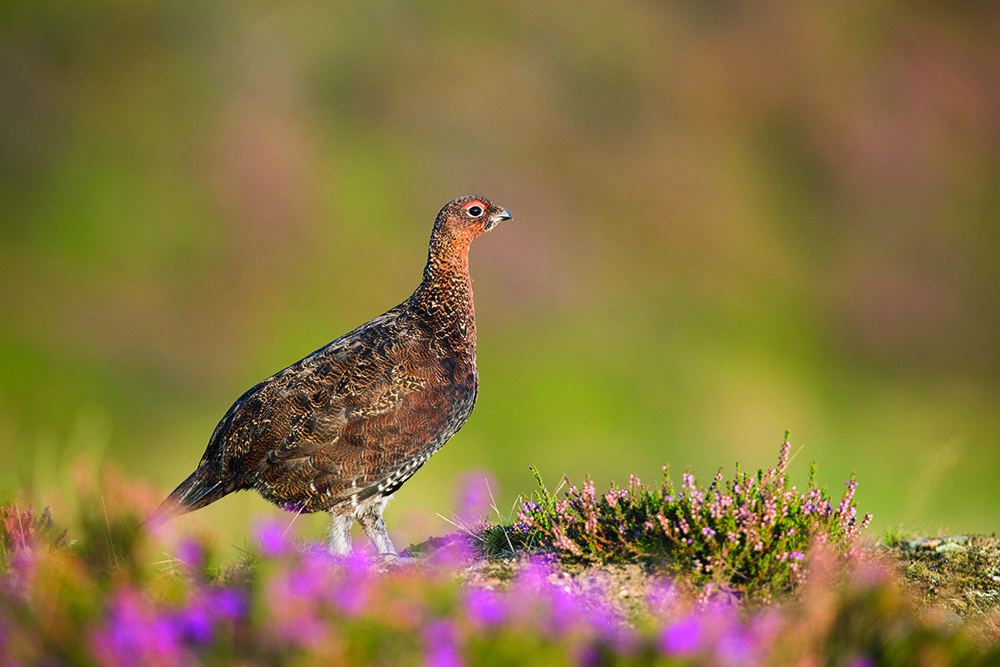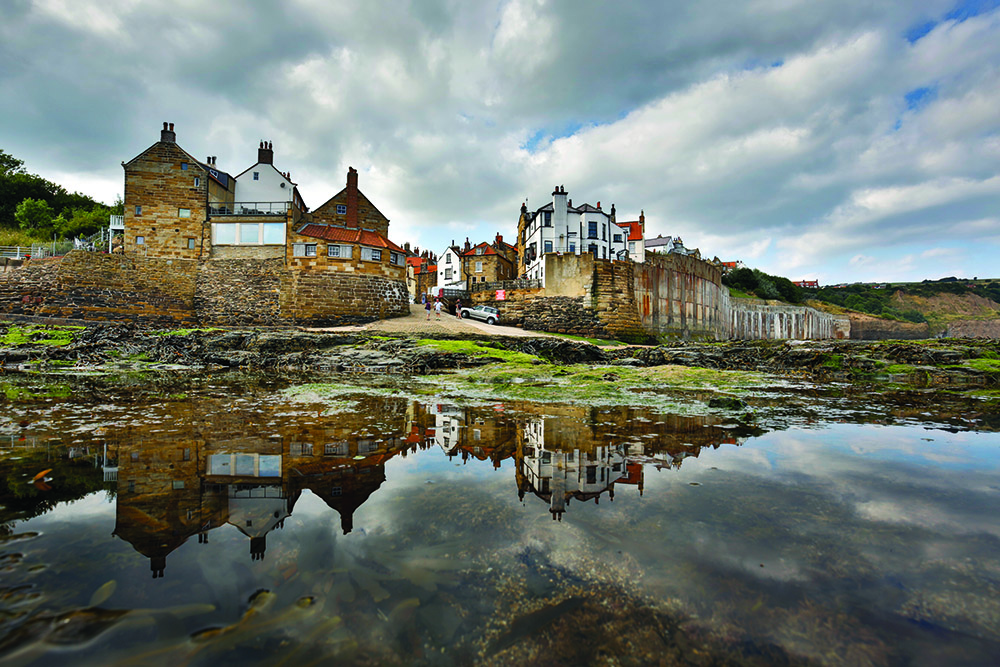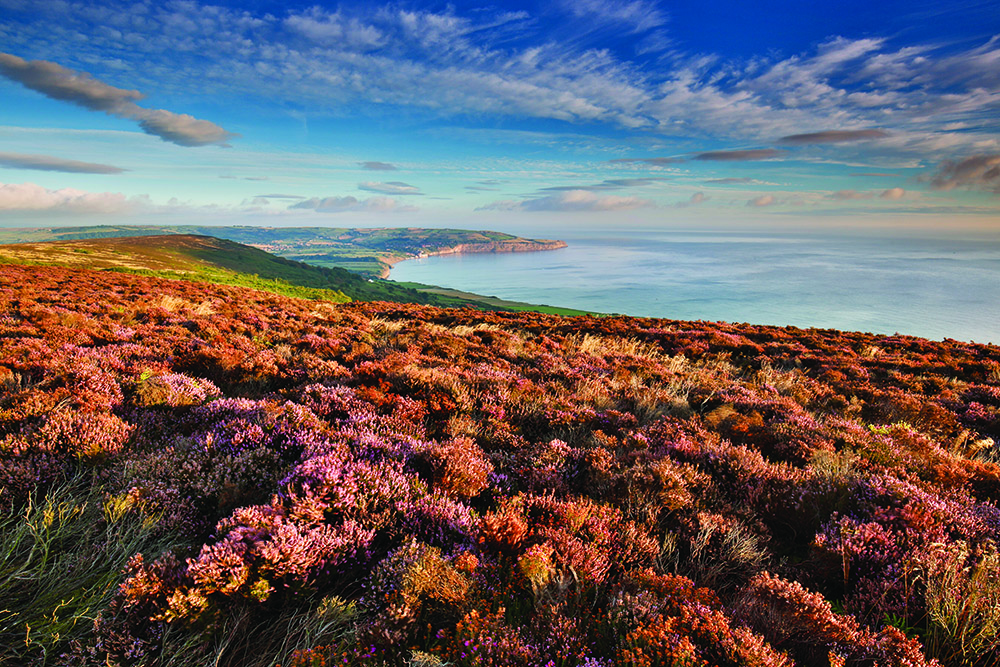Motorhome travel: Wildlife spotting in Yorkshire

MMM's David Chapman discovers what dazzling delights beckon motorhomers to this dramatically beautiful and wildlife-rich region of Yorkshire.
It had been more than a quarter of a century since either my wife, Sarah, or I had been to the North Yorkshire Moors and we both felt a desire to return. Scarborough, Robin Hood’s Bay, Whitby, Staithes and Goathland, of TV fame both in Heartbeat and Harry Potter, were all on the list. So, too, was a trip on the North Yorkshire Moors Railway, but I also wanted to get a better understanding of the wildlife that can be seen in this national park.
We started our trip with a visit to Wykeham Forest, where there is a raptor viewpoint. Over the course of the year an impressive selection of birds of prey are seen from this viewpoint overlooking a steep-sided valley. Early morning in spring is a good time to see goshawk here.
In summer, there are hobbies and honey buzzards; red kites are often seen, as are sparrowhawk and kestrel. But, on a cloudy and windy day in September I only saw a buzzard and a sparrowhawk, but I did spot a couple of crossbills in the treetops. We stayed our first night at Scarborough West Ayton Caravan and Motorhome Club site where I was delighted to be able to watch tree sparrows on the various feeders near the entrance.
Nearby, in the ancient woodland of the Forge Valley National Nature Reserve, we found a layby where the birds are regularly fed. It was easily possible to photograph nuthatch and marsh tit from the ’van window. We also saw great spotted woodpecker and jay.
Saying hello to Scarborough
We moved to the Scarborough Camping and Caravanning Club site, within walking distance of Scarborough, where Sarah wanted to pay her respects at the grave of Anne Brontë and I wanted to have a look around the harbour. It was low tide and I watched a kingfisher speeding low across the shallow water on which cormorants were fishing.
At the muddy margins, turnstones foraged. I noticed that a young herring gull was caught on a fisherman’s hook, which was stuck fast on the rocks near the harbour mouth. The tide was coming in and it was clear that the gull would drown. I raced down the slippery steps. Luckily, the mud was firm enough for me to cross to the gull and the water around it was still shallow enough for me to paddle through. I got hold of the bird, despite its protestations, and unfastened the hook to release it before also removing the hooks and line from the rocks.
Moving on to Ravenscar
Feeling very pleased, we headed to our next site near Ravenscar, just a few miles to the north. We chose a site within easy walking distance of the coast and went to explore the beach, which is down a very steep path from the visitor centre. The view from here, of Robin Hood’s Bay, is beautiful and the heather-clad slopes beside the path very colourful.
Apart from common heather (ling) there was bell heather, harebells, eyebright and goldenrod. In the sea and on the rocks at low tide were an incredible 70 or more seals, mostly common but with a few grey. It was getting towards evening when I left the beach and made my way back up the steep path. In the rough below the golf course, a female roe deer hopped casually into the long grass only a few yards from me.
The walking from Ravenscar is very good, with many paths and some long-distance routes to choose from. On Brow Moor, just 10 minutes from the site, is the start of the Lyke Wake Walk, a 40-mile-in-a-day challenge that I have done a couple of times. On this occasion a walk on this part of Fylingdales Moor Special Protection Area interested me more.
Fylingdales Moor Special Protection Area
This large area of moorland is managed by the Hawk and Owl Trust; its aim being to increase the number of merlin and short-eared owl breeding on the moor as well as many other key species, including golden plover, lapwing, snipe and curlew. In September, insect life is in full swing. In the damper patches on Brow Moor I saw common hawkers and some black darters.
On our way to the next site at Robin Hood’s Bay we stopped at another part of the same moor to follow a Hawk and Owl Trust nature trail at Jugger Howe. We found a leaflet for this walk and learned a lot about the nature of the wider area as well as this particular trail. For instance, I might have guessed there were redstarts and cuckoos in spring and early summer, but I wouldn’t have known to expect water voles on the moorland streams.
I found green tiger beetles on the dry paths and heath butterflies on the grassy areas. A snipe flew over, making its squelching call and a flock of siskin fed in the waterside alders of Jugger Howe Beck. It was the valley of this beck that provided most interest, with sundew in flower and plenty of common lizards basking on the sections of boardwalk. I also found a dark bush cricket basking here. Other flowers included cowberry and cross-leaved heath, whilst the bog asphodel had gone to seed and the bilberries were ready for picking.
Coastal walks
We had several walks along the coast and, apart from Ravenscar to Robins Hood’s Bay, our next favourite was from Runswick Bay to Staithes. Both Runswick and Staithes typify the quaint red-roofed harbour villages built into steep-sided valleys of the area and are hard to resist.
We were fortunate to coincide our visit with the annual Staithes Arts and Heritage Festival when over 100 cottages become temporary art galleries and the harbour plays host to an evening light show. In terms of wildlife around Staithes there is a seabird colony on Cowbar Nab which, I believe, hosts kittiwake, fulmar and razorbill in spring and summer.
In September, though, I only saw a few kittiwakes at sea as well as a few common terns passing by and some fulmars soaring around the cliffs. Along the coastal fringe between Runswick and Staithes we saw plenty of the very pretty wall brown butterflies. Birds included yellowhammers, linnets, skylarks and some tree sparrows near Port Mulgrave. There are also a lot of red-legged partridge here which were introduced for shooting. House martins are more common than swallows and there are places where they make their nests on the cliffs.
Scaling Dam Reservoir
On the way to our next site at Lealholm we stopped for a walk at Scaling Dam Reservoir. There is a circular walk of about four miles taking in a variety of habitats including moorland, scrub, wood and the reservoir edge. In September there is every chance of seeing migrant birds here. One of the semi-regular highlights is the osprey for which a nesting platform has been erected.
There is enough reservoir edge to attract some passing waders; for example, green and common sandpipers. The only migrants we saw were wheatear, chiffchaff, meadow pipits in very large numbers and hirundines hunting over the water. The lake plays host to a large mixed flock of greylag and Canada geese. We also saw great crested grebe, teal, cormorant, reed bunting, grey heron and many lapwing.
Late summer flowers, along the sometimes overgrown paths, included sneezewort and beautiful Devil’s-bit scabious. However, the nature reserve section, where most birds tend to congregate, is not particularly easily observed. It is a long way from both the hide and the circular path so it isn’t always easy to identify smaller birds. Lealholm is a pretty village with a great bakery.

Armed with quiche and rocky road we had a wander on the moors of Glaisdale where we saw lots of red grouse, a flock of about 40 golden plover and a kestrel hovering overhead. Coming back from Glaisdale along the River Esk, we saw grey wagtail and dipper. This is an important river for salmon and freshwater pearl mussels.
The North Yorkshire Moors Railway
I wish we had longer to explore the area around the River Esk, but Sarah was keen to see the steam trains on the North Yorkshire Moors Railway. Her grandfather was a guard in the days of steam, so I said I would take her to a good location to watch the steam trains. I even timed our visit to coincide with one going in each direction! What I didn’t tell Sarah was the name of the spot where we would go: Fen Bog. You can see why I didn’t tell her and you can probably imagine why I chose it.
Fen Bog is a Site of Special Scientific Interest, being one of the best examples of an upland valley mire in Britain. How can you resist a nature reserve that has a ‘quaking bog’? As you might imagine it is a difficult reserve to explore without wellies, though it is possible to walk along the edge. Whinchat, wheatear and redstart breed on, or near, the reserve and a wide range of wetland flowers can be found here, including butterwort, sundew, bog asphodel, bogbean, bog myrtle and marsh violet. I found a few clusters of autumn gentian just coming into flower on the track leading down to the reserve.

Thankfully, it didn’t disappoint on the steam train front. Subsequently, we also walked from the Hole of Horcum to Newtondale for the same purpose. Newtondale is an impressive and beautiful steep-sided valley, a wonderful place to stop and admire the amazing landscape. We saw a family of stonechats along the route but, with a temperature of 25˚C, most of the wildlife we saw was close to the two ponds on the return route.
We watched a southern hawker laying eggs and both common hawkers and black darters were present. We watched a skylark bathing in dust rather than water. On the areas of moorland on which bell heather was in flower, butterflies abounded with small tortoiseshell, red admiral and small heath being common. In spite of the heat, rather than because of it, I saw a female adder on the south-facing slope above Dundale Pond.
Exploring Rosedale
We then had a day on the railway exploring the tourist attractions and tea shops of Goathland and Grosmont before moving to The Howard Rosedale Abbey Caravan and Motorhome Club site. Rosedale is an exceptional area for wildlife with many breeding ring ouzels, whinchats, redstarts and other typical moorland species.
Our evening walk up to the ironstone mines at Bank Top rewarded us with our finest view of the trip. From the old tramway on top of the ridge we watched a flock of lapwing in flight, a whole host of red grouse and five ring ouzels as the sun set and the full moon rose. That’s the sort of wonderful experience that lives forever in the mind.
Later the next day, we took a walk along the old railway line across High Blakey Moor and it is here that I saw two merlins. The merlin’s a very small falcon, much smaller and somewhat darker than a kestrel. Unlike the kestrel, a merlin will not hover. After the merlin it was time for The Lion – The Lion Inn that is – the only refuge on this remote moor, to enjoy light refreshments.
Our final site was close to Helmsley. We went to Duncombe Park, adjacent to the village, where there is a pleasant walk through woodland, parkland and along the river. This is designated a National Nature Reserve because of its large number of ancient and veteran trees and has breeding hawfinch, lesser spotted woodpecker, redstart and spotted flycatcher.
On a hot afternoon in September I had to make do with nuthatch, green woodpecker, grey wagtail and lots of stock doves. We ended our trip at Sutton Bank, where there are a variety of walking trails. There are many birds to see in the woodlands and clearings of Sutton Bank and, in some years, peregrines nest on the cliffs. Sutton Bank, notorious for its near-vertical escarpment, provided us with another amazing view and a fitting climax to a wonderful trip.
This feature was originally published in the Summer 2017 issue of MMM magazine. Looking for more motorhome travel inspiration? Subscibe to MMM and enjoy travel and campsite features every month!









.jpg)




Recent Updates
Engine management lights: all you need to know
What is the engine management light? What does it mean, and what do I have to do? ...
Motorhome air suspension: all you need to know
Motorhomes are heavy and the additional weight of equipment and height of the bodywork can increase the loads ...
Motorhome WiFi: how to get better motorhome internet
Staying connected on the move is more and more essential, so relying on campsite WiFi isn't an option – here ...
A class of their own - our guide to A-class motorhomes
Thinking of trading up to an A-class, or even going straight to the top of the motorhome tree? We guide you ...
Explore overseas on a motorhome dream tour
Enjoy exotic travel in a campervan or motorhome by hiring, swapping with someone else or exporting your ...
Motorhome water systems: everything you need to know
On-board water is an important part of every motorhome – here’s everything you need to know ...
Campervanning in Europe: what you need to know
Whether you're planning a leisurely drive through the French countryside, navigating bustling city streets in ...
Campervan security: all you need to know
With thefts on the increase, it’s important to know how to keep your campervan secure and prevent campervan ...
Campervan furniture: everything you need to know
Our campervan experts guide you through all the essentials for your campervan, including tables, chairs, ...
Campervan finance: how to fund your purchase
Here we look at the different types of campervan finance available, to help you decide what’s the best option ...
Other Articles
Britain’s best used motorhomes
Want a great motorhome without paying the premium for a new one? Here's a guide to the best you can get in the pre-owned market for each layout, ...
Which motorhome? Choosing the perfect motorhome for you
Choosing a motorhome or campervan is one of the biggest buying decisions you’ll ever make, so it's important ...
Campervan washroom essentials: stay fresh on the road
Our guide will take you through the campervan washroom essentials you'll need so you're well-prepared for ...
Dogs in campervans: all you need to know
Follow our advice and your dog will enjoy campervanning as much as you do ...
Electric campervans: all you need to know
Our guide will take you through everything you need to know about electric campervans and what the future ...
Motorhome electrics: a complete guide to your motorhome electrical set-up
Motorhome electrics can dramatically enhance the convenience and comfort of your vehicle – but they can be ...
Lighting for campervans: all you need to know
We guide you through all the lighting options available for you and your campervan, including interior ...
Electric bikes for motorhomes: our ultimate guide
Read our comprehensive guide to electric bikes for motorhome owners, helping you add electric power to your ...
Our guide to 'cheap' motorhomes in 2024
If you're on the hunt for an affordable new motorhome, this is the best place to start – we've rounded up a ...
Campervans in winter: all you need to know
Here's your guide to preparing your campervan for the colder months, whether you will be using it or putting ...